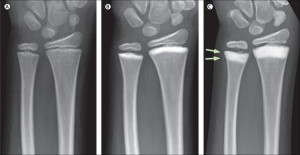osteosclerosis <-the pdf. Osteosclerosis is increased bone density.
Osteosclerosis induced by denosumab
“A 10-year-old boy, 144 cm tall, was referred to our hospital in October, 2012, with a 2 month history of persistent pain in the buttocks. He had altered gait due to pain, but no disturbance of bladder or bowels. Radiographs, CT, and MRI showed a large osteolytic lesion in the sacrum, and examination of a bone biopsy sample confirmed a giant cell tumour of bone, which we considered to be unresectable because of the potential risk of neurological deficit and massive bleeding. We obtained informed consent from the patient and his parents and the review board for off-label use of denosumab, a potent inhibitor of osteoclastic bone resorption, to reduce the tumour mass. We gave subcutaneous denosumab 120 mg every 4 weeks, with loading doses on days 8 and 15 of the first cycle. Due to the excellent clinical response and the obvious sclerotic changes along the growth plates (figure) we stopped treatment after five cycles (seven injections). The sclerosing bands were seen in almost all the radiographs of metaphyses, most prominently in the distal radius and ulna, and also in the proximal humerus, proximal femur, and phalanges of the fingers. During the 5 months off treatment the tumour grew again, so we restarted treatment with denosumab for 4 months until the tumour had reduced enough in size for surgery to be safely carried out. Before surgery repeat radiographs showed double-layered sclerotic bands at the metaphysis (figure), reflecting the longitudinal bone growth during the periods on and off denosumab. At last follow-up in March, 2014, the patient showed no signs of growth retardation (151 cm tall), was able to participate in sports without pain, and showed no evidence of tumour recurrence.”
“(A) Plain radiograph of the right wrist before denosumab. (B) Metaphyseal sclerotic bands in the distal radius and ulna after five cycles of treatment. (C) Double-layered sclerotic bands (arrows) after two courses of denosumab with an interval between the treatment.”
The growth plates seem to be longer after osteoclasts have been inhibited but note that taller growth plates doesn’t always lead to increased height.
Growth retardation assessment was done after two years so permanent alterations will have to be longer.

